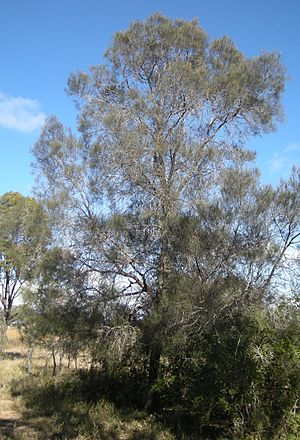Buloke facts for kids
Quick facts for kids Buloke |
|
|---|---|
 |
|
| Scientific classification | |
| Genus: |
Allocasuarina
|
| Species: |
luehmannii
|
 |
|
| Occurrence data from AVH | |
Allocasuarina luehmannii, also known as buloke or bull-oak, is a special type of tree from Australia. It's famous for having some of the hardest wood you can find!
Contents
About the Buloke Tree
This amazing tree is an evergreen plant, meaning it stays green all year round. It usually grows quite tall, between 10 and 20 meters (about 33 to 66 feet). It often has a clear, straight trunk. Buloke trees can live for a long time, often more than 15 years, and they grow at a moderate speed.
Male and Female Trees
The Buloke tree is dioecious. This means that male flowers and female flowers grow on separate trees. So, you'll find some trees that only have male flowers and others that only have female flowers. They usually flower in the spring.
The Hardest Wood?
The wood of the Buloke tree is known for being incredibly hard. Some sources say it has the hardest wood in the world! This is measured using something called the Janka hardness test. This test shows how much force is needed to push a small steel ball into the wood.
One test showed a very high hardness of 5060 lbf (pounds-force). However, other information, like from The Wood Database, suggests a slightly lower but still very high hardness of 3,760 lbf. Even with different numbers, it's clear that Buloke wood is one of the toughest woods around!
What are Cladodes?
Instead of wide, flat leaves, the Buloke tree has special parts called cladodes. These are like modified stems that look a bit like needles. They are usually 8 to 22 millimeters (about 0.3 to 0.9 inches) long. Each cladode has 10 to 14 small "teeth" and can sometimes feel waxy.
Where Buloke Trees Grow
The Buloke tree grows across a large area of eastern and southern Australia. You can mostly find it north and west of the Great Dividing Range. It's common in the Murray-Darling Basin and in the states of New South Wales, South Australia, and Victoria.
Threats to Buloke Trees
Sadly, many Buloke trees have been cut down. This happened to make space for growing crops and creating pastures for animals. This has greatly reduced where the trees can be found.
The Buloke tree is very important for a special bird called the red-tailed black cockatoo. In the Wimmera region of western Victoria, this endangered bird relies on the Buloke tree for food. Some groups of these trees are still in danger because of farming practices.
Growing Conditions
Buloke trees can grow in many different types of soil, but they prefer sandy loams. You'll often find them in lower parts of the landscape. They can handle soils that are acidic, alkaline, or even a bit salty.
Named After the Tree
The Shire of Buloke in Victoria, Australia, is actually named after this amazing tree species!
How the Buloke Tree Was Named
The Buloke tree was first officially described in 1900. A botanist named Richard Thomas Baker gave it the scientific name Casuarina luehmannii. He wrote about it in a paper called On two new species of Casuarina.
Later, in 1985, another botanist named Lawrence Alexander Sidney Johnson reclassified the tree. He moved it into a new group, or genus, called Allocasuarina. This is why its full scientific name today is Allocasuarina luehmannii.
Gallery
See also
 In Spanish: Allocasuarina luehmannii para niños
In Spanish: Allocasuarina luehmannii para niños




